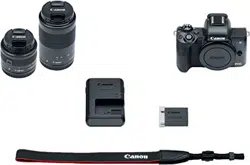Loading ...
Loading ...
Loading ...

47
Index
Appendix
Errors and Warnings
Troubleshooting
Settings
Playback
Shooting
Setup and Basics
Learning About the Camera
Accessories
Wireless Features
Wireless Features/Accessories
Setup and Basics
Handling Precautions
● The camera is a high-precision electronic device. Avoid dropping it or
subjecting it to strong impact.
● Never bring the camera near magnets, motors, or other devices that
generate strong electromagnetic elds. Strong electromagnetic elds
may cause malfunction or erase image data.
● If water droplets or dirt adheres to the camera or screen, wipe with
a dry soft cloth, such as an eyeglass cloth. Do not rub hard or apply
force.
● Never use cleaners containing organic solvents to clean the camera
or screen.
● Use a blower brush to remove dust from the lens. If cleaning is difcult,
contact a Customer Support Help Desk.
● Store unused battery packs in a plastic bag or other container. To
maintain battery performance if you will not use the battery pack for
some time, about once a year charge it and then use the camera until
it runs out of power before storing the battery pack.
● Do not touch the camera or lens contacts. This may cause the camera
to malfunction.
● To avoid damaging the image sensor, do not touch it when it is
exposed after a lens is removed.
● Do not block the shutter operation with your nger, etc. Doing so may
cause a malfunction.
● After detaching the lens from the camera, put down the lens with the
rear end up and attach the lens caps to avoid scratching the lens
surface and electrical contacts.
● Besides dust entering the camera from outside, in rare cases lubricant
from the camera’s internal parts may adhere to the front of the sensor.
If spots are still visible on images after automatic sensor cleaning,
contact a Customer Support Help Desk to request sensor cleaning.
● Periodically cleaning the camera’s body and lens mount with a soft
lens cleaning cloth is recommended.
Part 2:
Learn about setting up the camera and performing basic camera
operations.
Learning About the Camera
Loading ...
Loading ...
Loading ...
